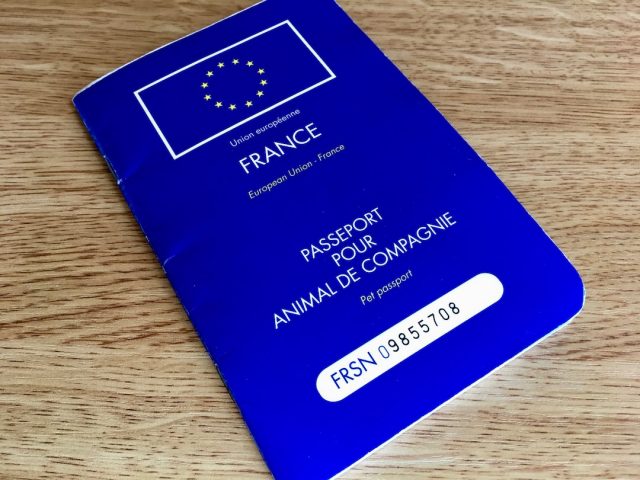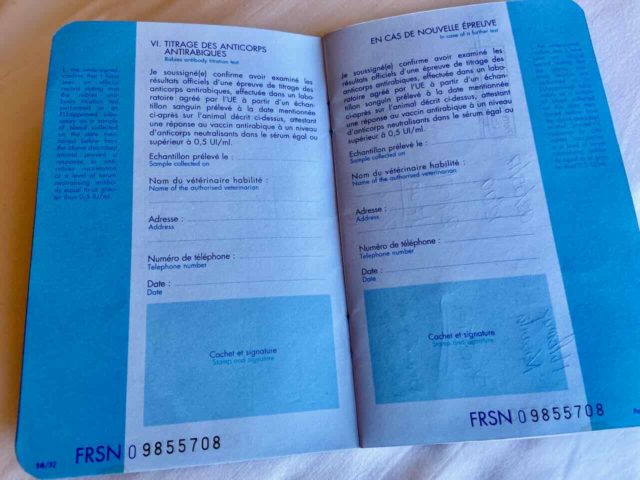How to Take Your Dog to Europe
I was talking to a sassy American woman on the cusp of retirement. She was buying my car and asked why I was selling a fairly new vehicle with such low mileage. When I told her I was going to Italy—with no plans to return—she got a dreamy, faraway look in her eyes…then looked a little sad. She would love to go to Europe, she said, but she couldn’t bear to leave her pets behind.
That’s when I gave her the good news: You can take your pets from the U.S. to Europe. In fact, today I’m sitting in a cozy apartment overlooking a moody autumnal landscape in Riga, Latvia, with my dog, Luna, snuggled up on the couch next to me.
Since that conversation, Luna has been to 19 European countries, and we’ve already booked #20 (Lithuania) and started dreaming about #21 (Greece).
So…how did I, a U.S. citizen, get Luna, a U.S.-born pooch here?
Research, patience, and paperwork. Here are some simple steps that will get you and your dog safely, legally, and happily to Europe.
1. Make sure your dog is healthy, microchipped, and ready for travel.
To travel internationally with your dog, you’ll need to get an international standard microchip (HomeAgain is a common brand) and make sure your dog is up-to-date on his or her vaccines (especially the rabies shot, of which the most recent shot must be given at least 21 days and no more than 12 months before your trip).
Many countries, including all those in the European Union, require pet dogs, cats, and ferrets to be microchipped before travel. A microchip compatible with ISO standard 11784 or 11785 is recommended. If your pet has a different microchip, consider buying a microchip reader and taking it with you. And note that, if you have to get your dog microchipped, you must do it before you get your dog’s latest rabies vaccine, so at least three weeks before your trip.
2. Check the dog travel policies of your preferred airline.
On some airlines, like Delta, XL Air, or Air France, a few small dogs are allowed to travel in-cabin, while large dogs travel as cargo. Other airlines require that all pets travel as cargo. Keep in mind that many airlines don’t accept pets in cargo during the hot summer months, as this area isn’t air conditioned while the plane is on the runway.
3. Check the requirements and fill out the paperwork for your first destination.
Bear in mind the requirements are set by the country of destination, not the U.S. If you are arriving directly in Italy, you’ll need a veterinary certificate in English and Italian. If you are flying into France, you’ll need one in English and French. And if you are cruising or flying into the U.K., there are a few extra guidelines you’ll need to follow and extra fees you’ll need to pay, which you can find on the DEFRA website.
For any of these countries, you’ll need a USDA-approved vet to fill out the above mentioned paperwork, usually within 10 days of travel (in the case of the U.K., within 5 days). Make sure to ask the vet about their certification. Then you can either mail your papers or drive over to the nearest USDA office for a stamp of approval. This stamped paperwork is what the customs officials will want to see when you arrive.
Keep in mind that each USDA office has slightly different policies (for example: in San Diego, I had to show up between certain hours and wait in line for my paperwork approval; in Denver, I had to make an appointment), so contact your local office ahead of time to find out about appointments, fees, and payment options for the fees.
4. Make sure you’re ready for travel.
If you have a nervous dog, ask your vet about safe sedatives for the trip and make sure to bring your Thunder Shirt or a comforting toy. This is only recommended for dogs traveling in-cabin where you can supervise them.
If you’re flying with your pet in-cabin, you’ll need a soft-sided, flexible pet carrier that will fit under the seat (and don’t trust the marketing—you can find airline seat measurements at www.dogjaunt.com and measure carriers to make sure they’ll fit). You may also want to bring treats to keep blood sugar levels up, a portable water bowl, and pee pads (if your dog is trained to use them), which you can take to the bathroom for a mid-flight potty break.
If your dog is flying as cargo, make sure your hard-sided case meets the airline’s requirements (which vary from airline to airline and can be found on the airline’s website) and consult with your vet about how much food or water to leave with your pet.
5. When traveling between European countries…
The USDA paperwork is officially good for travel within the E.U. for up to 90 days. If you are traveling in or moving to the E.U. for more than 90 days, you’ll need to complete one final step: getting your European pet passport. This passport documents all vaccinations and health check-ups and allows your dog to travel freely in between European countries.
To get a pet passport, you’ll need to make an appointment with a local vet in your first destination. They’ll check your vaccination records (so make sure you have those) and your pet’s microchip and fill out a small passport style booklet that declares your pet micro-chipped and healthy. Usually, this process can be done in the office same day, but it’s always smart to give yourself an extra day or two just in case (my first pet passport, for example, ended up taking two days and two visits due to a typo).
A handful of European countries have additional requirements for pet travel, so if you’re traveling to multiple countries, always make sure to check the official requirements before you go. Norway, and the U.K., for example, require a tapeworm treatment administered by a vet five days (or less) before you cross their borders. And if the U.K. executes a no-deal Brexit this year, there will be additional paperwork required to travel between the E.U. and the U.K.
European countries not yet in the E.U. are also subjected to additional requirements (Montenegro, for example, is a high rabies risk country and you will need a blood titer test done by an E.U.-approved lab at least 30 days before your trip if you want to re-enter the E.U. after visiting the pretty coastal vacation spot).
6. Finally, enjoy your new home.
Dogs are absolutely adored in France, Italy, and other European countries. They’re often allowed in restaurants, cafés, bars, and shops. Overall, Europe is far more pet-friendly than the U.S.

Get Your Free Report on Europe Here:
Learn more about countries in Europe and other countries from around the world in our daily postcard e-letter.
Simply enter your email address below and we’ll also send you a FREE report – All the Charm and Romance of Europe…at a Price You Can Afford.
Rules to Travel With a Dog Between European Countries
One of the best things about travelling around Europe with a dog is that you don’t need to visit a vet and fill in paperwork to travel between many countries, unlike in other parts of the world. This is thanks to many of the countries in Europe belonging to the European Union (or EU for short) and its single set of rules making it easy for pets to travel around the EU and a handful of other countries.
But what preparations are required to travel with your dog in between EU countries? Which border crossings does this apply to? And what about the rules for travelling with your dog between other countries? I take you through all the rules for dog travel between European countries.

Travelling Between EU and Related Countries
When travelling between countries within the EU and a number of “related” countries, this page sets out the requirements for your dog. Essentially, your dog needs to be microchipped, have been vaccinated for rabies at least 21 days ago, and have a pet passport. For a handful of countries, there is also the requirement for the dog to have a worming treatment.
What Countries are in the European Union?
Currently, there are 27 countries in Europe that are part of the EU. These countries are: Austria, Belgium, Bulgaria, Croatia, Cyprus, Czech Republic, Denmark, Estonia, Finland, France, Germany, Greece, Hungary, Ireland, Italy, Latvia, Lithuania, Luxembourg, Malta, Netherlands, Poland, Portugal, Romania, Slovakia, Slovenia, Spain, and Sweden.
Additionally, since the United Kingdom transitioned out of the EU following Brexit, Northern Ireland is still counted as part of the EU for the purposes of pet transport.
What are the “Related” Countries?
The EU counts a small number of other countries and territories as applying rules equivalent to the EU for the transportation of pets. The same rules apply for dogs crossing from these countries into EU countries. The pet passport can be either an EU pet passport or a pet passport issued by one of these countries.
These countries are also referred to as “Part 1 listed” countries and are listed on this page in the top table. These seven countries and three territories are: Andorra, Faroe Islands, Gibraltar, Greenland, Iceland, Liechtenstein, Monaco, San Marino, Switzerland and Vatican City State. Additionally, Norway is included.

Switzerland is a “Part 1 listed” country
Note however that more onerous conditions may apply for transporting pets back into some of these countries! This is the case for both the Faroe Islands and Iceland. The Faroe Islands only allows pets to be imported if you intend to stay for longer than three months, while Iceland requires a 14-day quarantine period and pets can only be imported from a short list of approved countries.
What Countries Require a Worming Treatment?
For a handful of the EU and related countries, a worming treatment is required to be administered to your dog by a vet, before arriving in the country. This is also referred to as the “treatment against Echinococcus multilocularis“. It needs to be administered between 24 hours and five days before arrival and recorded in your pet’s passport.
This is required for dogs travelling to: Finland, Ireland, Malta, Northern Ireland and Norway and the United Kingdom. Note that this treatment is not required for dogs travelling in between these countries, such as between Northern Ireland and Ireland.

A worming treatment is required for dogs heading to Ireland
Do Pets from Other Countries Require a Pet Passport?
If you travelled from outside of the EU with your pet, you would have required an animal health certificate or “Annex IV” to enter the EU. If you initially entered one of the related countries, you would have likely used the same or a similar form.
When you arrive in Europe, you should try and get this stamped by customs. Even if it isn’t stamped, you should hold onto it during your travels around Europe. This certificate is then valid for travel within the EU for four months after your entry and should be shown in place of an EU pet passport.
Alternatively, you may be interested in getting an EU pet passport for your pet. The pet passport makes it easier to return to Europe with your pet. (You don’t need to have an Annex IV completed, unless your pet has been vaccinated outside of the EU.)
If you need to have a worming treatment done by a vet, it’s easiest to get an EU pet passport at the same time. (This is what I did before travelling to the UK with my dog, prior to Brexit.)
Are Pet Passports Really Checked?
Just like human passports are often not checked when travelling in between the Schengen countries, pet passports are generally not checked when travelling within the EU and these related countries, at least when not flying. Although there is always the expectation that your pet does have a passport and it may be checked!

An EU pet passport is required for crossing borders
Other than when checking into flights, our pet passport was only checked when we travelled to Malta, plus when we travelled to the United Kingdom prior to Brexit. Malta is one of the countries that is quite stringent with the importation of pets, and I recommend reading my specific guidelines for how to take your dog to Malta.
I’ve also heard of someone being turned down for boarding a ferry to Corsica from mainland France, as their dog’s rabies vaccine wasn’t up-to-date.
On the other hand, despite also needing a worming treatment for dogs travelling to Finland and Norway, our dog’s passport wasn’t checked on either occasion, both at a road crossing and when boarding a ferry.
Any Additional Requirements for These Countries?
Generally, I’ve assumed that there are no additional requirements for pets travelling into any of the EU countries. However, this is not always the case.
For instance, when travelling to Malta you also need to advise the country in advance of your pet’s arrival, so that they can be checked by a vet on arrival. As Malta doesn’t have any land borders, you’ll likely be reminded of this if booking a flight or ferry trip to the country with your dog. I’ve covered the whole process in my guide to travelling to Malta with a dog.

Pets travelling to Malta need to be checked by a vet on arrival
Sweden also has the requirement to advise the country of your dog’s arrival, but only at the customs declaration point or through an online form, with no need to do it in advance. I didn’t actually find out about this until I was leaving the country, and luckily didn’t suffer any consequences. I cover this fully in my guide to travelling in Sweden with a dog.

Pets travelling to Sweden also need to be declared
I’m not aware of any other EU country that has any additional requirement, but I recommend double-checking the individual country websites listed here, if in doubt. When it comes to related countries, as I mentioned above both the Faroe Islands and Iceland have quite strict entry procedures.
What About Puppies?
There are some exceptions to the rabies vaccination requirements for young animals that are too young to be vaccinated. I don’t recommend travelling with animals so young for a holiday, but if they are crossing the border to go to their new home refer to the EU regulations.
Travelling into the EU from Other European Countries
If you are travelling into an EU country or one of the related countries from another European country, the rules are more complex and similar to travelling to Europe with your dog from elsewhere in the world.
Depending on what country you are travelling from, a rabies titre test may or may not be required. Additionally, an animal health certificate or “Annex IV” will be required if you don’t have a pet passport from the EU or a related country.
Which Countries Require a Rabies Titre Test?
If you are travelling into the EU from these European countries, a rabies titre test is required: Albania, Armenia, Azerbaijan, Georgia, Moldova, Montenegro, Serbia, Turkey, Ukraine.
A rabies titre test is not required for “Part 2 listed” countries, as listed on the bottom table on this page. These five European countries are included: Belarus, Bosnia and Herzegovina, North Macedonia, Russia, United Kingdom (including Guernsey, Isle of Man and Jersey).
What are the Requirements of the Rabies Titre Test?
There are a number of rules stipulated by the EU for the administration of a rabies titre test, if your dog requires one to travel to the EU.
The sample for the test needs to be collected by an authorised veterinarian at least 30 days after your dog is vaccinated for rabies. The sample needs to be tested in an EU approved laboratory. Assuming a sufficient level of antibodies are detected (0.5 IU/ml or greater), you then need to wait three months after the sample collection date to enter the EU.
The rabies titre test though remains valid for the life of your pet, as long as they always receive their rabies vaccine booster shot before the previous one expires.
What About Pets from the EU?
If your pet is originally from the EU, it is advisable to get a rabies titre test done before leaving the EU. In this case, there is no waiting period applied. You can immediately travel back to the EU without waiting for three months after the rabies titre test. There is a section in the EU pet passport for recording your dog’s rabies titre test.

There is a section in the EU pet passport for recording rabies titre tests
As noted above, the rabies titre test remains valid for the life of your pet, as long as they receive their next rabies booster shot before the previous one expires. If this doesn’t occur, your pet will require another rabies titre test (hence the room for recording multiple tests).
Is the Paperwork Really Checked?
During my travels around Europe, I didn’t actually make it to any of these countries. At first I wasn’t sure of the requirements for dogs travelling in between the countries (and didn’t realise that my rabies titre test from Australia was valid), and then I later ran out of time. So, I don’t have personal experience at travelling between these countries and the EU.
However, I have been informed by other travellers, that paperwork is not always checked when travelling from these countries into the EU. This includes travelling from Serbia into Bulgaria. However, it is advisable to always comply with the regulations and expect that paperwork may be checked.
If you go to cross the border and you haven’t had the rabies titre test done for your dog, there is a long waiting period. Especially if your dog is originally from within the EU and could have skipped the waiting period entirely!
What Entry Points are Allowed?
If you are entering an EU country or any of the related countries with your dog, you are required to enter at specific entry points, where your dog’s paperwork can be checked. These are known as “Travellers’ points of entry”, and may include airports, shipping ports and land border crossings.
To view the list of relevant entry points for each country, click here.
Travelling out of the EU to Other European Countries
When travelling from a country in the EU or one of the related countries to other countries in Europe, the list of requirements differs between different countries. You should check the requirements for the individual country.
Often it is sufficient to assume that travelling with your dog’s EU pet passport and an up-to-date rabies vaccine is sufficient, but this is not always the case.
At the moment, I have not yet travelled personally with my dog to these countries or investigated the details of the rules for most countries. As I investigate each country, I will list them here.
A handy initial place to check the rules is PetTravel.com, but always check the relevant government website to double-check your have the latest rules and the full details required.
Importing a Dog to Serbia
The rules to import a dog to Serbia are quite similar to the rules for importing a dog to EU countries.
For dogs being imported to Serbia from EU countries and the related countries, the rules are listed at the top of this page. Your dog needs to be permanently identified (such as by a microchip), vaccinated against rabies, comply with comply with any preventive health measures for other diseases, and be accompanied by either a passport or a health certificate, quite similar to the EU health certificate.
There are also rules listed for both Part 2 listed countries (as per the EU legalisation) and unlisted countries (generally higher risk countries). For unlisted countries, a rabies titre test is also required, performed by an EU approved lab, followed by a waiting period of three months.
Importing a Dog to Turkey
The rules to import a dog to Turkey are not that clear, with different interpretations on different websites. At a minimum, your dog needs to be microchipped and vaccinated against rabies, at least 30 days in advance.
It is likely the 3-year rabies vaccine isn’t recognised, so make sure you dog has been vaccinated in the last year. Additionally, a rabies titre test may or may not be required. Read my full discussion on the rules for travelling to Turkey with a dog.

The rules to travel with a dog to Turkey aren’t that clear
Is the 3-Year Rabies Vaccine Recognised?
Within the EU countries, the 3-year rabies vaccine is recognised. This means that if your dog receives a 3-year rabies vaccine, your dog does not need a booster shot for another three years. However, there are some countries around the world that only recognise 1-year rabies vaccines, and required your dog to have a booster shot yearly.
The following European countries require a yearly rabies vaccine (according to my investigations): Belarus, Moldova, Montenegro, Russia, Turkey, Ukraine.
Taking Your Dog to Europe: Vaccines & Paperwork
So, you’re planning on taking your dog to Europe, whether on a holiday or for a longer stay. Europe is a great place to take your dog, as it’s certainly the most dog-friendly region of the world. Plus it’s usually easy to travel between countries in Europe with a dog, at least within the European Union (EU). But, how do you travel to Europe with your dog in the first place, in particular the EU?

Travelling to the European Union with a Dog
If you’re travelling to the EU with your dog, the rules to enter with your dog are virtually the same for every country. There’s no need to track down different rules for each country, you just need to learn the one set of rules.
The complete rules are set out on this single page on the European Commission website. The rules are fairly clear and this page should always be your final port of call (as sometimes rules do change). But to save you deciphering this page, here’s everything you need to know about taking your dog to Europe in simple language.

This could be you, exploring the delights of Budapest with your dog at your side
What Countries are in the European Union?
Currently, there are 27 countries in Europe that are part of the EU. These countries are: Austria, Belgium, Bulgaria, Croatia, Cyprus, Czech Republic, Denmark, Estonia, Finland, France, Germany, Greece, Hungary, Ireland, Italy, Latvia, Lithuania, Luxembourg, Malta, Netherlands, Poland, Portugal, Romania, Slovakia, Slovenia, Spain, and Sweden. The same rules for dogs apply to all these countries.
Note that the UK has now left the EU, although the rules to travel with a dog to the UK are still essentially the same.

The UK is no longer part of the EU, but pet travel rules remain similar
Microchip Your Dog
Your dog needs to have a microchip (“transponder”) to travel to the European Union, which should be readable by standard microchip readers. The one exception is for dogs that have a clearly readable tattoo that was applied before 3rd July 2011.
For many other countries, such as my home country of Australia, this is already generally done to all puppies. Even if you’re not taking dogs to Europe, it’s still a good idea to have them microchipped so that they are more easily reunited with you if they become lost.
Vaccinate Your Dog Against Rabies
Europe is largely rabies free, although wildlife-mediated rabies still occurs in some countries, including in the EU. Due to this, it’s a requirement that your dog is vaccinated against rabies before travelling to the EU.

Your dog will need to be vaccinated against rabies © Depositphotos
If you’re vaccinating your dog for the first time, it must be completed at least 21 days before arriving in the EU (plus allow time for the rabies antibody titration test, if required, see below). Otherwise, any booster vaccinations must have been completed before the previous vaccine expired. (If not, you’ll need a new “primary” vaccine and to wait at least 21 days.)
If you’re newly microchipping your dog, the microchip needs to be done before the anti-rabies vaccine. Note that your dog also usually needs to be at least 12 weeks old when the anti-rabies vaccine is administered (there are a few exceptions for some countries).
Also consider a vaccination for leishmania if heading to Southern Europe – check out my tips for avoiding leishmania
Is a Rabies Antibody Titration Test Required?
Depending on the country you are travelling from, a rabies antibody titration (titre) test may be required. This test confirms that your dog has been successfully vaccinated against rabies.
To see whether your country is exempt from this requirement, check the countries listed in both tables on this page. Some of the exempt countries include the United States, Canada, Mexico, Australia, New Zealand and Singapore. Most other countries in Europe but not in the EU are also on the list. This means your dog does not require this test.

Many countries are exempt from a rabies titre test, including Mexico
If your country is not exempt, the test must be done at least 30 days after your dog is vaccinated for rabies (if vaccinated for the first time) but not less than 3 months before arriving in Europe. It needs to be done by an authorised veterinarian and tested in an approved laboratory, with an antibody level equal to or greater than 0.5 IU/ml detected.
Once this test has been successfully done once, it doesn’t need to be renewed as long as your dog is revaccinated before any anti-rabies vaccine expires.
Is a Worming Treatment Required?
Depending on the country you are travelling to (not from in this case), your dog may require an additional preparation step, a worming treatment.
Before travelling with your dog to Finland, Ireland or Malta (plus Norway or the United Kingdom), they need to be wormed against Echinococcus multilocularis. This treatment must be done by a veterinarian, between 24 hours (1 day) and 120 hours (5 days) of your scheduled entry time.

Dogs require a vet-administered worming treatment before heading to Ireland
Note that this step also applies if you’re within the EU and are travelling into any of these countries, except for travelling directly between them.
For instance, if you’re travelling to France and then travelling to the UK, your dog needs to have a worming treatment between 1 day and 5 days before your arrival in the UK. (See my full guide to travelling between countries in Europe.)
Paperwork to Enter the EU with Your Dog
Naturally, all of this needs to be documented somewhere and presented on arrival in Europe, in the same way that you need a passport. For your dog, this is called an “animal health certificate” (or officially, the “EU Annex IV”). This also certifies that your animal is in good health and is up-to-date on the standard dog vaccines.

The paperwork is the same to travel to most EU countries, including Austria
The health certificate needs to be completed and issued by an official veterinarian, or else by an authorised veterinarian and then endorsed by the relevant government authority. (Check with your government.)
It needs to be issued by the official veterinarian within 10 days of entering the European Union. The only exception is for transport by sea, where the period is extended by the duration of the sea journey.
There’s also a second form that you’ll need to fill in yourself, stating that your dog’s movement is non-commercial and that if someone else (an “authorised person”) is transporting the dog, it is being done within 5 days of your movement.
For the forms, head here.
Where Can Your Dog Enter the EU?
Your dog must enter the EU through entry points designated by each country, where documentary and identity checks are then able to be performed. The possible entry points for each country are listed here. Generally most major airports are included.
Travelling to Other European Countries with a Dog
For other European countries that are not in the EU, the rules to enter the country with a dog vary, although often the same steps apply for dogs entering the EU.
I can provide details on some countries, including the following:
Iceland: The process is more onerous. Dogs can only be imported from approved countries and a a 14-day quarantine period is required, see the government website. I recommend leaving your dog behind unless you are moving to Iceland long term.
Norway: The rules are similar to those in the EU. Norway also requires a worming treatment for your dog, similar to Finland, see above. See the latest government rules.

Norway has similar rules for pets entering the country
Switzerland: The rules are similar to those in the EU. See the latest government rules.
Turkey: Read my full post on Travelling to Turkey with a Dog, although the rules are not that clear and their application varies.
United Kingdom: The rules are essentially the same as those for the EU, although there is now a Great Britain-specific pet health certificate. Read my full post on Travelling in the UK with a Dog.

There is a Great Britain-specific pet heath certificate
I recommend checking the relevant government websites for the full details required, including that you have the latest rules, although a handy place to start is the IATA Travel Centre (under Customs, Currency and Airport Information).
Also note that the following European countries (according to my investigations) do not recognise 3-year rabies vaccines, requiring yearly vaccine: Belarus, Moldova, Montenegro, Russia, Turkey, Ukraine.
Travelling Between European Countries with a Dog
Once you have arrived in Europe with your dog, you might be planning to travel to multiple European countries. Luckily, it’s often quite easy to travel between European countries with your dog, particularly in the European Union. Check out my guide to travelling with a dog between European countries.
In particular, if you travel to the EU with your dog, their health certificate used to enter the EU remains valid for four months, or until the expiry date of their rabies vaccine, whichever occurs first. During this time, the certificate can be used for their transport into other member states of the EU.
If you want to stay longer and travel to other European countries, head to a local vet and get your pet a European pet passport. From then on, this is the important paperwork document for your dog, including their rabies vaccine.

Consider an EU pet passport for longer stays in Europe
While most human tourists to Europe have restrictions on how long we can stay, there’s no upper limit on how long your dog can stay in Europe.
Source https://internationalliving.com/traveling-to-europe-with-a-dog/
Source https://www.travelnuity.com/dog-travel-between-european-countries/
Source https://www.travelnuity.com/travelling-to-europe-with-a-dog/